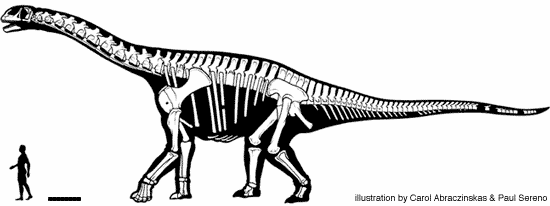Dinosaur Paradise
Long before any of our remotest ancestors inhabited the African rain forest or savanna, the continent was home to some amazing dinosaurs. The best-known of these (the biggest!) was Jobaria tiguidensis, a plant-eating or sauropod dinosaur that lived about 135 million years ago in what is now Agadez in Niger, West Africa. Jobaria is named after Jobar, a legendary beast that frightens young children (particularly those who misbehave) in this part of Niger, although the dinosaur itself was no threat to others except in defense.

Jobaria tiguidensis. Source: Project Exploration
Jobaria was an unusually primitive dinosaur for its age, which raises many interesting questions about how the diversity of sauropods evolved. Unlike other early Cretaceous sauropods, Jobaria had a much shorter tail and a smaller number of less-complex vertebrae. It weighed about 20 tons and was about 70-75 feet long including the tail. At the field site discovered by Paul Sereno in 1997, roughly 50 specimens were found together, having apparently died in a flash flood. The large number of skeletons indicated that Jobaria traveled in herds, just like the animals that today inhabit that region.
Dinosaurs discovered in Africa have also made the big screen in Hollywood. In Jurassic Park III, the large dinosaur featured in the movie is the Spinosaurus. In 1912 the first Spinosaurus was found in Egypt. It was far from a complete skeleton - just skull pieces, some teeth, various parts of the spine, and incomplete ribs. Since the skeleton was found by a German geologist and paleontologist Ernst Stromer, the fossil bones were brought to Germany. From these pieces of skeleton it was determined that Spinosaurus aegyptiacus was 50 foot reptile with a large sailback, crocodile-like jaws and sharp teeth.Tragically, the fossils were destroyed in 1944 during a World War II bomb raid. Paleontologists have yet to find another Spinosaurus skeleton and have to rely on the few sketches and images that survived the bombing.

The Spinosaurus with a smaller sketch showing the actual bones discovered. Source: Casper College's Prehistoric FAQs
What
do YOU think? Dinosaur hunting in Africa...
How easy do you think it is to dig for dinosaurs in Africa? What might be some of the logistical issues you would face? There is a report that Cretaceous dinosaurs fossils exist in Ingal, Niger. Using your Collins-Africa map, find this location and examine the surroundings. What might be some of the challenges you would face going to Ingal, spending three weeks to dig up a dinosaur skeleton, and transporting this skeleton back? Post your thoughts and opinions to the Lesson 02 Discussion Forum in ANGEL. You can easily find that discussion forum by looking under the Communicate tab in ANGEL.